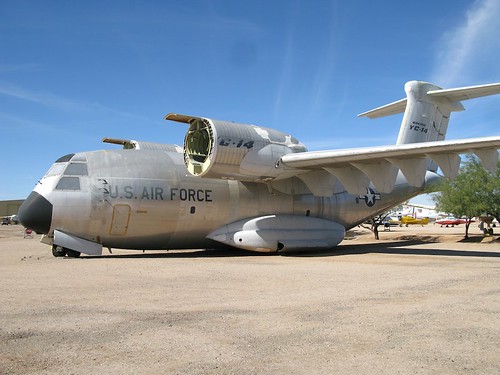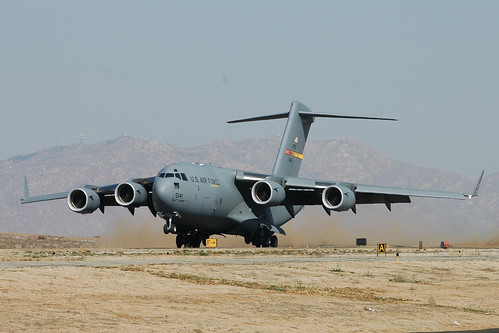I’m putting this Air-Minded post back at the top of the blog because it’s an interesting bit of aviation history; new, I hope, to some of my readers. I wrote it in 2012, at a time when Mitt Romney and John McCain were competing for the Republican presidential nomination and the US military services were floating dreams of expansion. The political picture is different today, of course, but we’re once again hearing about those evergreen military dreams: the Navy is pushing for a larger share of the defense budget in order to grow from 290 to 355 ships; the Air Force, similarly, wants to expand from 312 squadrons to 386; the Army and Marines … well, they’d love to grow too but can’t meet current recruiting goals, so their goals are somewhat up in the air.
My interest in USAF tactical airlift stays on a simmer because a number of C-130 Hercules aircraft are based in Tucson and I see them in the air every day. Until recently I drove by the boneyard every week on my way to work as a docent at a local air museum, passing acres and acres of mothballed C-130s in temporary storage. And of course, the museum where I worked has one of the YC-14 prototypes on display.
—Paul Woodford
In the recent presidential campaign, candidate Mitt Romney asserted that the US Navy today has fewer ships than at any time since 1917. It turned out that a campaign advisor named John Lehman, Secretary of the Navy under President Reagan and a man with “strong and complex personal financial ties to the naval shipbuilding industry,” was the author of that talking point.
I was on the joint staff during the Reagan years and I remember Lehman’s push for a 600-ship Navy. President Reagan and Secretary of Defense Weinberger would have given it to him too, if they hadn’t run out of money. But Lehman and the Navy were only part of Reagan’s massive military expansion. I remember my US Army colleagues dreaming of impossible WWII-level numbers of divisions. And I remember how we in the US Air Force fought for more F-15s and F-16s … and for the B-1 bomber, canceled during the Carter administration but reinstated by Reagan.
A decade before Reagan opened the treasury, however, the USAF had begun pursuing another dream: an all-jet fleet. That we were still flying propeller-driven aircraft in the 1970s was an insult, a galling reminder of olden times. We had gotten rid of all but one: the lowly Lockheed C-130 Hercules tactical airlifter. Never mind that the Herk’s props were driven by jet engines, we wanted a “pure jet” tactical airlifter.
The program to replace the C-130 began in the early 1970s with the Advanced Medium STOL (short takeoff and landing) Transport competition. There were two AMST competitors: Boeing’s YC-14 and the McDonnell Douglas YC-15:


Both aircraft were approximately C-130 size, though with wider fuselages designed to accommodate the Army’s M60 Patton battle tank. Both aircraft derived their low-speed, short-distance takeoff and landing capability from innovative powered lift designs: the YC-14 used a concept called upper surface blowing (USB), in which jet thrust followed the downward curve of large flaps located below and behind the engines; the YC-15 used externally blown flaps, in which jet thrust was deflected downward by large flaps lowered from above and behind the engines. You can get an idea of how the different powered lift concepts worked in these photos:


The companies built and tested two prototypes each. McDonnell Douglas flew the first YC-15 in 1975; Boeing began flying the YC-14 in 1976. By the time the YC-14 entered flight test, the program was already doomed: then-current USAF Chief of Staff General David C. Jones had decided not to push for an airlifter limited to tactical roles, instead issuing a new requirement for a large transport capable of meeting tactical and strategic airlift requirements. Inside scuttlebutt, of course, supplied the rest of the story: if what I heard at the time was true, congressmen representing the districts where C-130s, C-130 subassemblies, and C-130 parts were manufactured were responsible for shooting down its replacement.
When the AMST competition ended in 1977, the YC-14 prototypes were returned to Boeing. Today both are in Tucson, Arizona: one at the Pima Air & Space Museum and the other across the street in the boneyard at Davis-Monthan AFB. Both YC-15s were placed in the boneyard: one was briefly on display at the Pima Air & Space Museum but then returned to flight status and subsequently damaged. Today that aircraft is located at Edwards AFB, California. The second YC-15 was scrapped in place at the boneyard in April 2012 (and no, I don’t know why the Pima Air & Space Museum didn’t get it).
What grew out of the YC-14/YC-15 competition was, of course, today’s C-17 Globemaster III, a large airlifter with STOL capabilities. You can see the family resemblance to the YC-15, particularly in its use of externally blown flaps, and indeed the C-17 was a McDonnell Douglas design. Arguably, even though the AMST competition was canceled, McDonnell Douglas and the YC-15 won. But Boeing won too, since it acquired McDonnell Douglas in 1997 and now makes the C-17.

In 1976 the Russians copied some of the YC-14’s STOL design features (because of course they did), incorporating them into the Antonov An-72. As far as I know, the An-72 is the only aircraft flying today to use USB flaps.
The real winner of the AMST competition was the humble turboprop C-130 Hercules, still rolling off the Lockheed Martin assembly line in Marietta, Georgia, flying continuously for the USAF since 1957. Today’s model is called the C-130J Super Hercules, easily identified by its four six-bladed props … propellers which’ll still be in the USAF’s face for decades to come.

Links
Additional Images on Flickr